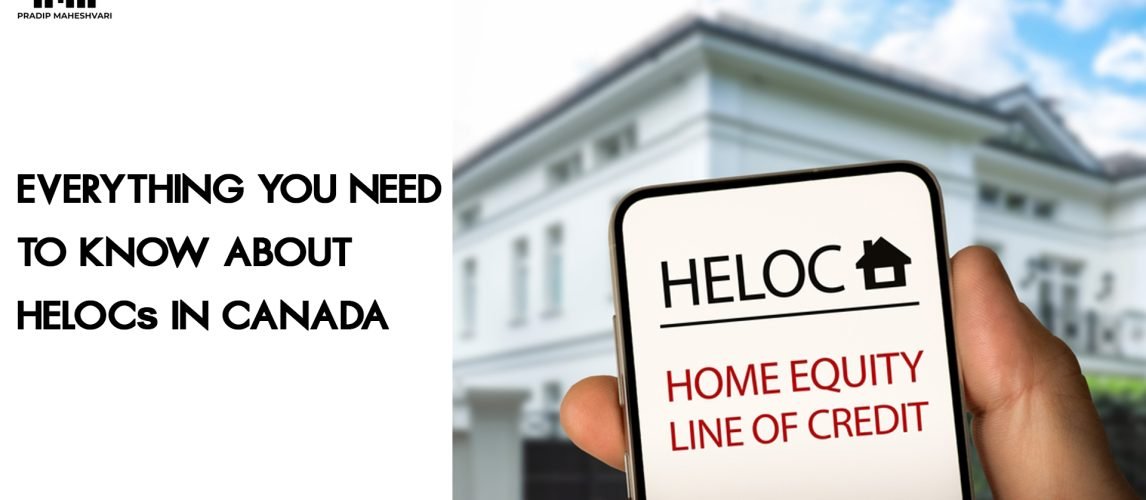A Home Equity Line of Credit (HELOC) is a flexible financial tool that allows homeowners to access their home’s equity as a revolving line of credit. It’s a popular choice for Canadians seeking funds for renovations, debt consolidation, or major purchases.
Here’s a complete guide by Pradip Maheshvari Mortgages to help you understand how HELOCs work, their benefits, and how to decide if this option suits your financial goals.
What Is a HELOC?
A HELOC is a secured loan where the credit limit is based on the amount of equity in your home. Unlike a traditional loan, a HELOC allows you to borrow and repay repeatedly within a set limit, much like a credit card.
- Example:
If your home is worth $600,000 and your remaining mortgage balance is $350,000, your equity is $250,000. In Canada, you can borrow up to 65% of your home’s appraised value through a HELOC.
65% of $600,000 = $390,000
Subtract your mortgage balance, and your maximum HELOC amount is $40,000.
How Does a HELOC Work?
- Flexible Credit Access: Borrow as needed within your credit limit, without taking a lump sum upfront.
- Interest-Only Payments: During the draw period (typically 5–10 years), you pay only the interest on the amount you use.
- Revolving Credit: Once you repay the borrowed amount, your credit limit is restored.
Advantages of a HELOC
- Flexibility
- Borrow only what you need, when you need it.
- Repay at your own pace within the terms of the agreement.
- Lower Interest Rates
- Compared to credit cards or unsecured loans, HELOCs have much lower rates because they’re secured by your home.
- Uses of HELOCs
- Home Renovations: Upgrade kitchens, bathrooms, or add living space.
- Debt Consolidation: Pay off high-interest debts like credit cards.
- Emergency Fund: Cover unexpected medical or family expenses.
- Investment Opportunities: Use funds to invest in stocks or a second property.
- Potential Tax Benefits
- In Canada, if you use HELOC funds for income-generating investments, the interest may be tax-deductible.
Things to Consider Before Getting a HELOC
- Variable Interest Rates:
HELOC rates fluctuate with market changes, which can increase your monthly payments over time.
- Discipline Is Key:
Since HELOCs are revolving credit, overspending can lead to excessive debt.
- Cost of Setup:
- You may face appraisal fees, legal fees, or administrative charges when setting up a HELOC.
- Ask your lender for a breakdown of these costs before proceeding.
- Repayment Terms:
After the draw period, some HELOCs require you to pay back the entire principal within a fixed timeframe, which may be challenging if not planned properly.
How to Qualify for a HELOC
- Sufficient Home Equity:
You need at least 20% equity in your home to qualify for a HELOC.
- Good Credit Score:
Lenders typically prefer borrowers with strong credit scores and reliable financial history.
- Stable Income:
A steady income assures the lender that you can manage interest payments and repay the borrowed amount.
Conclusion
A HELOC is a powerful tool for homeowners in Canada, offering financial flexibility and low-interest borrowing. However, it’s crucial to understand the terms, evaluate your needs, and ensure you use this resource wisely.
At Pradip Maheshvari Mortgages, we specialize in helping homeowners unlock the potential of their home equity through tailored solutions like HELOCs, refinancing, and more. With expert guidance, you can confidently make the best financial decisions for your future.
Contact Pradip Maheshvari Mortgages Today and learn how a HELOC can work for you!
You Might Also Like:
Five Best Ways to Use Home Equity in Canada
Equity Take Out vs. Mortgage Refinancing: Differences Explained!


No comment yet, add your voice below!